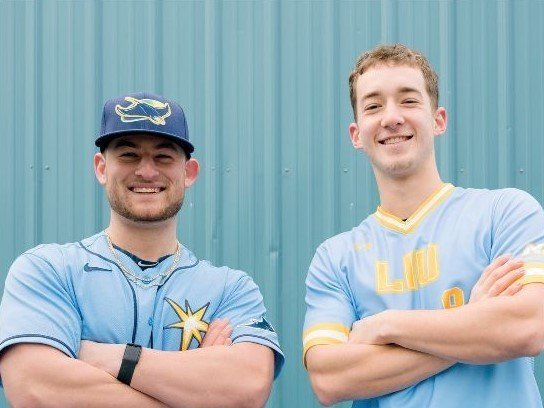Game On: From Noho to the Majors
Written by Melissa Karen Sances
Photos by Nikki Gardner Photography
Sponsored by Valley Home Improvement
Published in Northampton Living (March 2023)
“This is the dojo here. This is all our stuff,” says Erik Ostberg, gesturing toward two open duffel bags stuffed with gear that spills onto the floor. He clears off two metal chairs for Jack Power and me, then takes a seat behind the desk at Complex Sports Academy (Plex) in East Longmeadow. Ostberg, 27, and Power, 20, settle in and sip their Reign energy drinks. Last night was a late one in the cage.
The two Northampton-born athletes have lived and breathed baseball since they could wield a bat. Now Ostberg is a bona fide Major Leaguer, Power a Division I rising star. When they aren’t playing with the Tampa Bay Rays or the Long Island University Sharks, Plex is their home.
When I spoke with the left-handed catchers by phone for our January* sports article on Power, I was struck by their similarities. They are thoughtful and articulate. In-person, Power is a towering but gentle giant, unassuming and laser-focused. Ostberg, a stocky 5’10”, wears his big heart on his sleeve – for his father, for his brothers in baseball, for the lifestyle that he loves.
Ostberg leans back and shrugs, as though Plex’s aesthetic leaves something to be desired. But he’s right to call this a “dojo.” To the uninitiated it is unremarkable, this out-of-the-way practice space whose windowless office opens into endless astroturf. But to them? It’s a Field of Dreams.
When we walk out of the office, their sensei seems to materialize from thin air. The three haven’t been in the same space since Peter Fatse, 35, closed his renowned Advanced Performance Academy (AP) in Palmer in 2019. (His former business partner opened Plex a year later.) A Holyoke native who played ball at the University of Connecticut and for the Milwaukee Brewers, Fatse is now the hitting coach for the Boston Red Sox.
His eyes shine as he greets his protegees. “Me and Nick are going to be on the same field. We play each other this year. How crazy is that?” he tells Ostberg and Power. Nick Ahmed, now the shortstop for the Arizona Diamondbacks, grew up in East Longmeadow and was an AP regular, along with a core group of elite athletes including Ostberg and Power.
Fatse turns to me. “The point is, like everybody that was there is in pro ball now,” he says incredulously. “And it was just a small, inconvenient, cold barn.”
Cold Open
When an 18-year-old Ostberg met Fatse in 2012, AP was still under development. Fatse had been let go from the Brewers and felt he had peaked as a player. But he was fascinated by the biomechanics of hitting, and he was an adept teacher. Ostberg’s coach at the University of Hartford had worked with Fatse at UConn, and he suggested that the two meet. That summer, the college-bound catcher drove to Wilbraham where Fatse had rented a cage at Soccer City.
“It was pretty grimy,” says Ostberg of the unsavory venue. “But I had never met anybody that had played pro ball. So to me he was the same as a 10-year Big Leaguer. It was like, Man, he must know a lot.”
Ostberg had always been eager to learn. His father founded Northampton’s Cal Ripken League and wrote a coaches’ manual that Ostberg studied as intently as any related books or YouTube tutorials he could find. But once he met Fatse, his swing was never the same. On the weekends and college breaks, he drove from Connecticut to western Mass to hit with him. When Fatse opened AP in Palmer, Ostberg helped build the netting and lay down the turf.
“The way we measure success in hitting has changed a lot in the last 8 years. He was at the forefront of this change,” says Ostberg, who was on track for a record-breaking junior year. A torn PCL upset his steady trajectory, but not completely: he was drafted out of college in the 13th round.
Meanwhile, Power was making a name for himself in Cal Ripken, and his own father was involved in coaching and chatting up Rob Ostberg. The two dads arranged for their sons to meet, and Power was as starstruck as Ostberg had been with Fatse. Soon Power was another AP “cage rat,” arriving after school at 2 p.m. and staying until 10 p.m., taking breaks from hitting to hurry through his homework in the back.
At AP, hitting was a solvable but ever-changing equation and each batter brought his own variables to the plate. “And then all of a sudden you’ve got like 8 or 9 high-level dudes and there’s just a lot of conversations and a lot of notes and everybody’s learning,” says Ostberg.
Fatse’s cutting-edge techniques drew players of all levels to little-known Palmer. But few were willing to make the athletic, intellectual, and even spiritual commitment that Ostberg and Power had. Excellence required a high tolerance for failure. Performance was a matter of practice – and faith.
Power slugged his way through Northampton High School and into Long Island University. Ostberg rebuilt his body and was one of three remaining of the 40 drafted alongside him. Fatse was tapped by the Minnesota Twins, and then the Boston Red Sox.
“I think the best way to describe it is ‘unintentionally intentional,’” he says. “We all had similar aspirations in terms of just being really, really good at what we were doing. And that was intentional. But the outcomes were unintentional. Like whatever happened after that was just the byproduct of us all being in the same place.”
Rat Pack
In the cage, Power steps up to the plate while Fatse takes the makeshift mound. Ostberg stretches his hamstrings while he waits on-deck. “We put on a show last night,” he says. Fatse smiles and throws a pitch.
“We were at the College World Series last year, Pete,” says Power. “Well not actually, but we went to regionals.”
“Where?” Fatse asks.
“Maryland.”
“You guys played Maryland? That’s awesome, man.”
Power connects with a pitch – crack! – and the ball soars to center field, where it ricochets off the wall like a gunshot.
Still, with each at-bat, his brows furrow. Fatse watches intently, quietly calculating, admitting that when faced with a batter, his mind is always making adjustments.
“I’d love to hear that, by the way,” says Power.
“What’s that?” says Fatse.
“What you’re thinking right now.”
Everyone looks at Fatse. “So what I watch for a lot of times is what is natural and not natural. That’s probably the best way to describe it. If you’re doing something that does not look natural, like why? And then from there, you’re looking at the ball. The ball tells you something every time it’s hit.”
The floodgates have opened, and the guys can’t help nerding out. Fatse videotapes Power and consults with Ostberg, who knows Power’s swing as well as his own. They all crouch around home plate as Fatse demonstrates the ideal point of contact. The sophomore’s swing improves markedly.
“I’m always overthinking stuff,” admits Power. “When Pete is talking to me, I’m trying to think about everything he’s saying and incorporate it in every swing, so it’s definitely hard. But I am excited whenever we get to hit, and whenever I hit with Erik, because I know that I’m getting the best information out there.”
It’s easy to see why Fatse is at the top of his game. His wisdom has been earned – and learned. He imparts advice with confidence and humility, asking often, “Does that make sense?” His enthusiasm drives but never overpowers the conversation, because his excitement isn’t about him, it’s about what’s possible for the athlete. Maybe that’s why it’s contagious.
And when it comes to Ostberg and Power, precious. They are his younger brothers, the guys who will always look up to him, the guys he’s watched grow up. Sure, he’s big-time and they’re on the up-and-up. They’ll all go their separate ways for Spring Training. But sooner or later, they’ll make their way back together. Back home.







